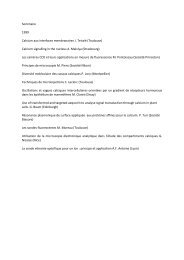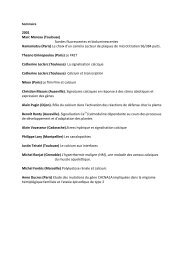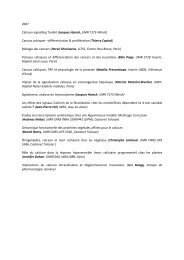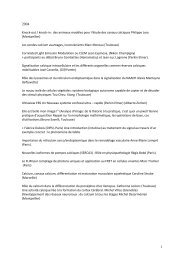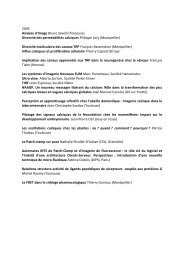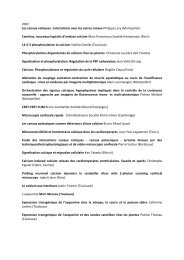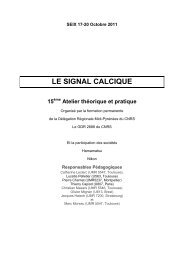SEIX 17-20 octobre 2005 - Atelier Calcium
SEIX 17-20 octobre 2005 - Atelier Calcium
SEIX 17-20 octobre 2005 - Atelier Calcium
You also want an ePaper? Increase the reach of your titles
YUMPU automatically turns print PDFs into web optimized ePapers that Google loves.
stranded RNA interference (RNAi) in the study of mAChR activated calcium signalling [4].<br />
Knockdown by RNAi of either the inositol 1,4,5-trisphosphate receptor and SERCA resulted<br />
in a reduction, in all cells tested, of carbamylcholine-evoked calcium transients to 10% or less<br />
of control values. This knockdown was achieved with soaking in dsRNA without the need for<br />
transfection agents, and only<br />
10 microgrammes of dsRNA per million cells was needed. Although RNAi knockdown of<br />
the DM1 receptor was much less effective in reducing carbamylcholine responses, we<br />
attribute this to the high levels of DM1 expression. [Fig. 3]<br />
Figure 3: Application of carbamylcholine (CCh, 100 M) induces an increase of<br />
intracellular Ca 2+ concentration [Ca 2+ ] i (A). Intracellular Ca 2+ response from cells<br />
loaded with Fura-2/AM are presented in the panels. Timing of drug application is<br />
indicated by a horizontal bar. Application of CCh elicits an increase of [Ca 2+ ]i in<br />
S2-DM1 cells (A) but also in S2-DM1 cells treated with DM1 dsRNA<br />
(B). However, no response to CCh is observed when the cells are treated with either<br />
Ins(1,4,5)P3R (C) or SERCA (D) dsRNA.<br />
COMBINING REVERSE GENETICS WITH CALCIUM MEASUREMENTS TO<br />
IDENTIFY NOVEL CALCIUM SIGNALLING COMPONENTS in DROSOPHILA S2<br />
CELLS<br />
The Drosophila genome contains approximately 14,000 genes and, of these, many remain to<br />
have a function assigned to them. Thus, it is likely that there will be many hitherto unknown<br />
genes that contribute to functions such as calcium signalling. Genome-wide RNAi screens<br />
have been fruitful in finding novel genes involved in the growth and viability of Drosophila<br />
cells [Boutros et al <strong>20</strong>04][6]. Our own studies (Raymond et al <strong>20</strong>04) [5] and those of Roos et<br />
al (<strong>20</strong>05) [7] have demonstrated the potential of using RNAi in conjunction with calcium<br />
93



